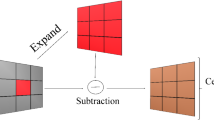Abstract
A gender classification system uses a given image from human face to tell the gender of the given person. An effective gender classification approach is able to improve the performance of many other applications, including image or video retrieval, security monitoring, human-computer interaction and so on. In this paper, an effective method for gender classification task in frontal facial images based on convolutional neural networks (CNNs) is presented. Our experiments have been shown that the method of CNNs for gender classification task is effective and achieves higher classification accuracy than others on FERET and CAS-PEAL-R1 facial datasets. Finally, we built a gender classification demo, where input is the scene image per frame captured by the camera and the output is the original scene image with marked on detected facial areas.
Access this chapter
Tax calculation will be finalised at checkout
Purchases are for personal use only
Similar content being viewed by others
References
Xia, B., Ben Amor, B., Huang, D., Daoudi, M., Wang, Y., Drira, H.: Enhancing gender classification by combining 3D and 2D face modalities. In: 2013 Proceedings of the 21st European Signal Processing Conference (EUSIPCO), pp. 1–5, September 2013
Timotius, I.K., Setyawan, I.: Using edge orientation histograms in face-based gender classification. In: 2014 International Conference on Information Technology Systems and Innovation (ICITSI), pp. 93–98, November 2014
Shan, C.: Learning local binary patterns for gender classification on real-world face images. Pattern Recogn. Lett. 33(4), 431–437 (2012). Intelligent Multimedia Interactivity
Huang, G.B., Mattar, M., Lee, H., Learned-Miller, E.: Learning to align from scratch. In: NIPS (2012)
Jabid, T., Kabir, M.H., Chae, O.: Gender classification using local directional pattern (LDP). In: 2010 20th International Conference on Pattern Recognition (ICPR), pp. 2162–2165, August 2010
Hadid, A., Pietikainen, M.: Combining appearance and motion for face and gender recognition from videos. Pattern Recogn. 42(11), 2818–2827 (2009)
Kumari, S., Sa, P.K., Majhi, B.: Gender classification by principal component analysis and support vector machine. In: Proceedings of the 2011 International Conference on Communication, Computing and Security, ICCCS 2011, pp. 339–342. ACM, New York (2011)
Li, B., Lian, X.-C., Lu, B.-L.: Gender classification by combining clothing, hair and facial component classifiers. Neurocomputing 76(1), 18–27 (2012). Seventh International Symposium on Neural Networks (ISNN 2010) Advances in Web Intelligence
Zhang, M.: Design and implementation of video-based face gender recognition system using manifold learning. Master’s thesis, University of Electronic Science and Technology (2013)
Chu, W.-S., Huang, C.-R., Chen, C.-S.: Gender classification from unaligned facial images using support subspaces. Inf. Sci. 221, 98–109 (2013)
Chen, H., Wei, W.: Support vectort aam based iterative learning algorithm for gender classification. J. Zhejiang Univ. (Eng. Sci.) 39(12), 1989–2011 (2005)
Nordstrøm, M.M., Larsen, M., Sierakowski, J., Stegmann, M.B.: The IMM face database - an annotated dataset of 240 face images. Technical report, Informatics and Mathematical Modelling, Technical University of Denmark, DTU, Richard Petersens Plads, Building 321, DK-2800 Kgs. Lyngby, May 2004
Lecun, Y., Bottou, L., Bengio, Y., Haffner, P.: Gradient-based learning applied to document recognition. Proc. IEEE 86(11), 2278–2324 (1998)
Zeiler, M.D., Fergus, R.: Stochastic pooling for regularization of deep convolutional neural networks. CoRR, abs/1301.3557 (2013)
Srivastava, N., Hinton, G., Krizhevsky, A., Sutskever, I., Salakhutdinov, R.: Dropout: a simple way to prevent neural networks from overfitting. J. Mach. Learn. Res. 15, 1929–1958 (2014)
The defense advanced research team: the facial recognition technology (feret) database. Technical report, United States Department of Defense (1996)
Gao, W., Cao, B., Shan, S., Chen, X., Zhou, D., Zhang, X., Zhao, D.: The CAS-PEAL large-scale chinese face database and baseline evaluations. IEEE Trans. Syst. Man Cybern. Part A Syst. Hum. 38, 149–161 (2008)
Lienhart, R., Maydt, J.: An extended set of haar-like features for rapid object detection. In: Proceedings of the 2002 International Conference on Image Processing, vol. 1, pp. I-900–I-903 (2002)
Rumelhart, D.E., Hinton, G.E., Williams, R.J.: Learning representations by back-propagating errors. In: Neurocomputing: Foundations of Research, pp. 696–699. MIT Press, Cambridge (1988)
Zeiler, M.D.: ADADELTA: an adaptive learning rate method. CoRR, abs/1212.5701 (2012)
Lu, L.: A study of gender classification and age estimation based on face image. Ph.D. thesis, Shanghai Jiao Tong University (2010)
Zhang, H., Zhu, Q.: Gender classification in face images based on stacked-autoencoders method. In: 2014 7th International Congress on Image and Signal Processing (CISP), pp. 486–491, October 2014
Acknowledgments
This research is partially supported by Beijing Natural Science Foundation (Grant 4152008). Hao is supported by the Foundation of Science and Technology of Beijing University of Technology (Grant ykj-2013-9341). We sincerely thank the anonymous reviewers for their thorough reviewing and valuable suggestions. In addition, the authors would also give warm thanks to Yutong Yu for the data labelling works, and Lei Wang and Zhiqiang Wang for their comments and discussions.
Author information
Authors and Affiliations
Corresponding author
Editor information
Editors and Affiliations
Rights and permissions
Copyright information
© 2015 Springer International Publishing Switzerland
About this paper
Cite this paper
Zhang, H., Zhu, Q., Jia, X. (2015). An Effective Method for Gender Classification with Convolutional Neural Networks. In: Wang, G., Zomaya, A., Martinez, G., Li, K. (eds) Algorithms and Architectures for Parallel Processing. ICA3PP 2015. Lecture Notes in Computer Science(), vol 9529. Springer, Cham. https://doi.org/10.1007/978-3-319-27122-4_6
Download citation
DOI: https://doi.org/10.1007/978-3-319-27122-4_6
Published:
Publisher Name: Springer, Cham
Print ISBN: 978-3-319-27121-7
Online ISBN: 978-3-319-27122-4
eBook Packages: Computer ScienceComputer Science (R0)





